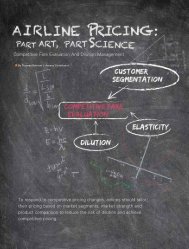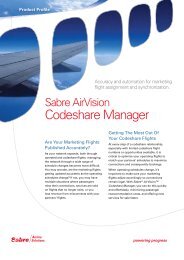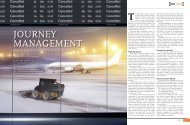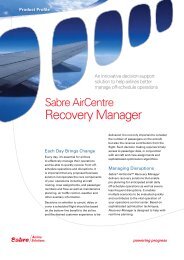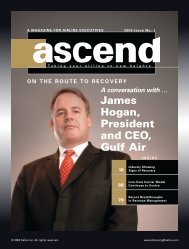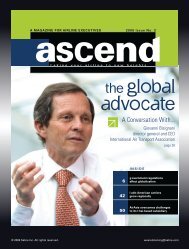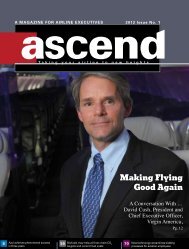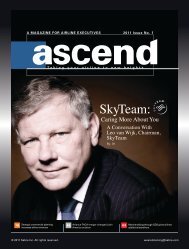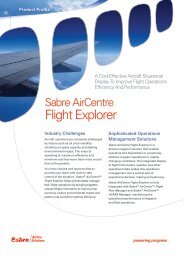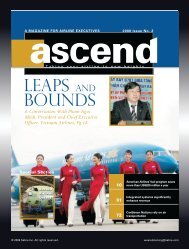2009 Issue 1 - Sabre Airline Solutions
2009 Issue 1 - Sabre Airline Solutions
2009 Issue 1 - Sabre Airline Solutions
Create successful ePaper yourself
Turn your PDF publications into a flip-book with our unique Google optimized e-Paper software.
to account for their actual emissions. They have the<br />
flexibility to buy additional allowances on the open<br />
market, and they may sell any excess allowances<br />
generated from reducing their emissions below<br />
their allocation. Participants that have not produced<br />
enough allowances to cover their emissions have<br />
to pay a fine of €100 (US$133) per ton for each<br />
excess ton emitted. This process becomes an<br />
incentive to reduce emissions such as investing<br />
in more efficient technology or using less carbonintensive<br />
energy.<br />
Participants are required to monitor and<br />
report emissions according to a plan approved by<br />
the regulator of each member state. After each<br />
calendar year, participants must surrender allowances<br />
equivalent to their verified CO2 emissions<br />
in that year. These allowances are then cancelled<br />
so they cannot be used again. Participants with<br />
surplus allowances can sell or save them for next<br />
year (within one trading period).<br />
Participants must report their CO2 emissions<br />
after each calendar year following E.U. monitoring<br />
and reporting guidelines. These reports have to be<br />
checked by an independent verifier using criteria<br />
in the ETS legislation. Participants with emission<br />
reports that are not verified as satisfactory are not<br />
allowed to sell allowances until a revised report is<br />
approved by a verifier.<br />
the carbon Market<br />
The buying and selling of allowances takes<br />
place on an open market, providing a flexible<br />
means for participants to comply with their emissions<br />
requirements.<br />
Participant companies can cost-effectively<br />
manage their emissions where emission allowances<br />
can be traded in the marketplace.<br />
Companies can access the market to buy<br />
allowances to meet their compliance requirements<br />
or to sell surplus allowances in several ways:<br />
Trade allowances with other companies in the<br />
system,<br />
Buy or sell allowances from intermediaries<br />
(banks and specialist traders),<br />
Use a broker to find other buyers and sellers of<br />
allowances,<br />
Join one of the exchanges that list carbonallowance<br />
products.<br />
E.U. ETS does not specify how or where<br />
trading in allowances should take place. Companies<br />
and other participants in the market trade directly<br />
with each other or buy and sell via a broker,<br />
exchange or any other type of market intermediary<br />
that has sprung up to take advantage of this<br />
significant new market.<br />
A whole range of new businesses has<br />
emerged in Europe as a result of the E.U. carbon<br />
market: carbon traders, carbon finance and carbon<br />
management specialists, and carbon auditors and<br />
verifiers. New financial products such as carbon<br />
funds have entered the market as well.<br />
The size of emissions trading is impressive.<br />
In the first half of 2008 versus the first half of 2007,<br />
the global emissions market grew more than 40<br />
percent, worth around €38 billion (US$50 billion).<br />
E.U. ETS comprised 70 percent of that global<br />
market.<br />
The carbon market itself was worth about<br />
€89 billion (US$118 billion) last year, up 84 percent<br />
versus 2007. The carbon market for <strong>2009</strong> is<br />
projected to be €113 billion (US$150 billion), up<br />
27 percent from last year, according to a report by<br />
London-based firm New Carbon Finance.<br />
Growth in the carbon marketplace during<br />
2008 came from higher carbon prices and greater<br />
transaction volume — about 4 billion emissions<br />
permits changing hands, 42 percent more than<br />
in 2007. Trade in European Union allowances, or<br />
EUAs, accounted for €71 billion (US$94 billion), or<br />
about 80 percent of the overall total.<br />
The EUA futures contract on the European<br />
Climate Exchange peaked at about €30 (US$40) in<br />
July, before recessionary pressure brought prices<br />
down to around €15 (US$20) by year’s end. Prices<br />
have continued to drop, and they reached a low<br />
of €8 (US$10) in early February. These low prices<br />
make it more economical to build new coal-fired<br />
power stations than to invest in renewable energy<br />
and smart infrastructure.<br />
Including Aviation In e.u. ets<br />
The new legislation passed on E.U. ETS last<br />
December affects aviation directly in the last year<br />
of the second trading period (2012) and the entire<br />
third period, which lasts eight years, from 2013 to<br />
2020. During the third trading period, the cap will<br />
change each year to meet the target of reducing<br />
CO2 by 20 percent over a baseline. The starting<br />
point of this line is the average of allowances to be<br />
issued by member states for the second trading<br />
period, plus adjustments to reflect the broadened<br />
scope of the system starting in 2013.<br />
The legislation passed in December adds<br />
aviation in its greenhouse gas emissions allowance<br />
within the European Commission. The reason for<br />
including aviation in E.U. ETS is because total E.U.<br />
greenhouse gas emissions fell by 3 percent from<br />
1990 to 2002, while emissions from international<br />
aviation in the European Union increased by almost<br />
70 percent. Aviation has grown at high rates relative<br />
to other sectors, putting CO2 emissions from<br />
airlines on the charts.<br />
Even though there has been significant<br />
improvement in aircraft technology and operational<br />
efficiency, this has not been enough to neutralize<br />
the effect of increased traffic, and the growth in<br />
emissions is projected to continue. Within Europe,<br />
commercial aviation is expected to double by<br />
2020.<br />
To address these problems, the European<br />
Union will pursue three complementary streams<br />
related to aviation: research and development for<br />
“greener” technology, modernized air traffic management<br />
systems, and market-based measures,<br />
namely ETS.<br />
research And Development for<br />
greener technology<br />
Joint technology initiatives, such as Clean<br />
Sky, are research initiatives that bring together E.U.-<br />
funded projects and major industrial stakeholders<br />
in aeronautics and aerospace to move important<br />
technologies closer to market.<br />
Modernizing Air traffic Management<br />
systems<br />
The Single European Sky legislation reforms<br />
the way air traffic management is organized in<br />
Europe. This requires a modernization of the air<br />
traffic management systems in Europe. The Single<br />
European Sky ATM Research, or SESAR, initiative<br />
is the technological component of Single European<br />
Sky. One of its objectives is to reduce emissions by<br />
10 percent per flight.<br />
The Atlantic Interoperability Initiative to<br />
Reduce Emissions, or AIRE, is a cooperative program<br />
between the European Union and the U.S.<br />
Federal Aviation Administration to coordinate two<br />
major programs on air traffic control infrastructure<br />
modernization, SESAR in Europe and NextGen in<br />
the United States.<br />
AIRE will make it possible to speed up<br />
the application of new technologies and operational<br />
procedures, which will have a direct impact<br />
in the short and medium term on greenhouse gas<br />
emissions. The measures include “smooth” or<br />
“reduced engine” approaches, which will enable<br />
noise and exhaust gas emissions to be reduced<br />
during landing. Experiments have shown substantial<br />
savings in fuel and CO2 and nitrogen oxide<br />
emissions. The European Union and the FAA have<br />
close involvement of partners from the industry<br />
such as Airbus and Boeing; airlines such as Air<br />
France-KLM, SAS, Delta Air Lines and FedEx; and<br />
aviation navigation service providers in Ireland,<br />
Sweden and Portugal.<br />
other Actions<br />
Other actions are being taken on renewable<br />
energy, such as biofuels as a renewable<br />
energy source for use in aviation. Renewables can<br />
contribute to security of supply, sustainability and<br />
competitiveness. A binding target of a 20 percent<br />
share of renewable energies in overall E.U. energy<br />
consumption by 2020 was agreed upon by the<br />
European Council in 2007, with a 10 percent binding<br />
minimum target to be achieved by all member<br />
states for the share of biofuels in E.U. transportation<br />
fuel consumption by 2020.<br />
e.u. ets starting Point for <strong>Airline</strong>s<br />
From 2012 on, all flights to and from<br />
E.U. airports will be covered by E.U. ETS. This<br />
includes E.U.-based airlines as well as airlines<br />
that are not part of the European Union.<br />
As with other participants in E.U. ETS,<br />
airlines will need to surrender emissions allowances<br />
for each ton of CO2 they produce.<br />
<strong>Airline</strong>s will also be able to apply for free allocations<br />
of allowances at the start of the reporting<br />
period by submitting verified activity data for a<br />
baseline year. Like other industries, airlines will<br />
be able to sell allowances they don’t need on<br />
the market. They will have to buy allowances<br />
if their emissions are higher or use emission<br />
ascend<br />
53<br />
special section



